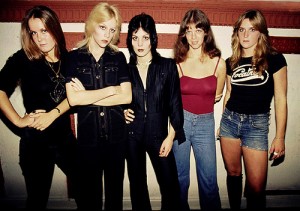The Runaways were one of the first all-female rock bands in the 1970s. They recorded and performed from 1975 to 1979. The band was formed in 1975 by Joan Jett and Sandy West (rhythm guitarist/songwriter and drummer, respectively) with the help of producer Kim Fowley. After several arrangements of members, the “original” five were completed by Lita Ford on lead guitar, Cherie Currie on vocals and Jackie Fox on bass.
Best known for their single, “Cherry Bomb,” The Runaways were not well-known in the United States during the time that they were active, achieving greater success in Japan due to that single and a successful 1977 tour.
“Cherry Bomb,” inspired by Currie’s “cherry-blonde looks and name,” was written on the fly at her audition to be the lead singer of the band after she had shown up planning to sing Peggy Lee’s “Fever.” Combined with Currie’s choice to don a pink coset she bought from a small lingerie shop, the success of the song impounded as Currie’s sexual appearance added to her stage presence, increasing the appeal of the song to their audiences. The song became the Runaway’s anthem and fight song, and by blatantly using Currie’s sexuality and sexual appeal, they inspired many people to divert from societal expectations and become more daring in their dress and expression.1
In an interview for a 2010 issue of Goldmine magazine, Currie said that she is “proud of what The Runaways did [. . .] That we went from just kids in the Valley – and Huntington Beach and Long Beach – to following our dreams and standing up there for the rights of girls and women everywhere, that [showed that] hey, we can do this and we can do it as well as [men] can.”
Shortly after their tour of Japan came to a close before 1978, the band’s lineup as followers commonly know it disbanded with Currie leaving. Throughout the band’s existence, the group has had five different bassists (Micki Steele, Peggy Foster, Jackie Fox, Vicki Blue and Laurie McAllister). Three members remained relatively unchanged: Joan Jett on vocals and guitar, Lita Ford on guitar and Sandy West on drums. The “original five” appear on their first three albums together, and for the final two, West, Blue, Ford and Jett performed as a quartet. Due to disagreements over which direction the band should go in musically, the band split up in 1979.
After their breakup, each member went on to pursue their own projects. Joan Jett went on to found Blackheart Records, through which she wrote and performed music as Joan Jett and the Blackhearts as well as helping other artists with furthering their work. Currie is under contract on Jett’s Blackhearts label and spends the majority of her time chainsaw carving after spending years as a drug counselor for addicted and at-risk teens. Ford and West worked on music together for a time that did not come to much fruition and are now involved with their own projects.
The Runaways were important to the rock genre because they were one of the pioneering all-female groups in the 1970s. Continuing in the vein of all-female musical acts prior to the 1970s, The Runaways trod into the unfamiliar territory of the male-dominated rock genre, using their sexuality as a mode for making their music accessible and appearing “less threatening” to male listeners as they sang songs about female liberation and rebellion to the pulse of heavy rock. The Runaways were a truly subversive, producing music that fit into an already rebellious genre, they achieved international success in a field that was not immediately welcoming to them while deconstructing the stereotypes the rock music industry had for women breaking into the genre.
Bibliography
1. Lindblad, Peter. “The Runaways’ ‘Cherry Bomb’ gets a chainsaw.” Goldmine (10552685) 36, no. 8 (April 9, 2010): 44-46. Music Index, EBSCOhost(accessed April 21, 2015).
2. The Runaways. Cherry Bomb: Live in Japan. Concert excerpt, Japan 1977.

